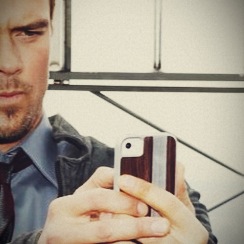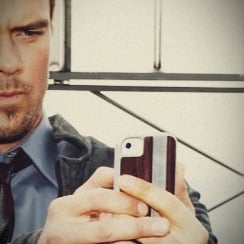Topics:
Search for topics or resources
Enter your search below and hit enter or click the search icon.

What and how we consume says a lot about what we value. And what and how we consume has never been more public.
Thanks to the broadcasting devices in our pockets and the social network audiences always just a few finger taps away, our interactions vis-a-vis culture are increasingly the means by which people make assumptions about who we are and what we worship.
 One of the premises of my new book, Gray Matters, is that in this consumerism-as-social-media-identity world, it is all the more imperative that Christians be intentional, thoughtful and critical in their consumer choices. People are watching. We are observed, processed, known through our consumptive habits. What message are we sending?
One of the premises of my new book, Gray Matters, is that in this consumerism-as-social-media-identity world, it is all the more imperative that Christians be intentional, thoughtful and critical in their consumer choices. People are watching. We are observed, processed, known through our consumptive habits. What message are we sending?
The new paradigm of digital/mediated/consumer “identity” is on disturbing display in Sofia Coppola’s new film, The Bling Ring, which depicts the true-life drama of a group of L.A. teens who robbed the Hollywood Hills mansions of celebrities in the late 2000s. The film’s opening is interspersed with snapshots of partying teens’ photos on Facebook and Instagram, and the plot turns on the way that social media makes one’s cultural consumption public, enviable, and (in this case) vulnerable to property theft. But what is most striking is the sheer proliferation of “selfies”: characters holding out their arms with phone cameras to document (and immediately publish to the world) all manner of pursed-lip posing, stolen cash flaunting, booze-imbing and other such glamorization of vice.
There’s an unsettling ambience of directionless vacuity in these youngsters’ lives. Where is their sense of purpose (moral or otherwise)? All that seems to animate their reckless behavior is the possibility that it will play well on social media or get picked up by TMZ.
Bling’s teen bandits are obsessed, first and foremost, with celebrity. But it’s not that they are fans of the films or television shows which made people celebrities in the first place. Nor is it that they are particularly interested in the celebrities as people, with unique personalities and stories. Rather, what interests these Millennials most about celebrities is simply the celebrity-ness of them: their paparazzi aura, nightclub exploits, tabloid scandals and--above all--haute fashion. In short: their conspicuous consumption. As Richard Brody observes in his New Yorker review of the film,
Nobody here cares very much about movies or television shows. Nobody talks about stories, and certainly nobody is reading anything other than magazines. They know the actors whom series and movies have turned into celebrities but have little interest in the shows themselves.
This sort of fetishizing of celebrity at its most superficial (the Louboutin heels, Rolex watches, Birkin bags and Herve Leger dresses they wear), isolated from any broader narrative of who they are and why they are famous, helps explains the existence of famous-for-being-rich people like Kim Kardashian and Paris Hilton. But it also reveals a larger cultural problem, which Brody pinpoints as “narrative deprivation.”
Today’s youth, reared in the Google age of on-demand, isolated bits of information and the real-time feeds of a million little “snapshots” (tweets, Vines, rabble-rousing blog posts, etc.), have no patience for narratives that give context or make connections. It doesn’t matter who Kim Kardashian is or how she became famous. What matters is that she gets to wear Lanvin dresses while on red carpets with Kanye West, while paparazzi take note of the slightest details of her Judith Leiber clutch. And these kids want that too. Brody continues:
In their selfies and their videos, the teens broadcast themselves living out crude fantasies of what, as one of them says, “everyone” aspires to be. What isn’t shared is the way they actually live: the teens don’t depict themselves breaking into houses and cars, stealing, selling stolen goods, or driving drunk. They don’t talk about their own lives in terms of stories. Rather, they live in a world that detaches effect from cause, and they depict only the outcomes.
Hence the sheer ubiquity of selfies. For them, earning jail time for thievery is a small price to pay for the opportunity to broadcast images of themselves wearing Prada sunglasses and guzzling Cristal at Lindsay Lohan’s favorite nightclub. It doesn’t matter what they had to do to get there (steal) or what will happen later (jail). The “now” of social media glory--however fleeting it may be--is what matters.
This “narrative deprivation” is symptomatic of (or perhaps another name for) “narrative collapse,” a phenomenon discussed at length in Douglas Rushkoff’s Present Shock. Rushkoff suggests that today’s world is defined by presentist, fragmented media consumption and an “entropic, static hum of everybody trying to capture the slipping moment.”
Narrativity and goals are surrendered to a skewed notion of the real and the immediate; the Tweet; the status update. What we are doing at any given moment becomes all-important--which is behavioristically doomed. For this desperate approach to time is at once flawed and narcissistic. Which “now” is important: the now I just lived or the now I’m in right now?
Social media’s “what are you doing now?” invitation to pose, pontificate and consume conspicuously only amplifies the narcissistic presentism of the generation depicted in The Bling Ring. It makes it easier than ever to tell the world exactly what you want them to know about you. Through a carefully cropped and color-corrected selfie, depicting whatever glamorized “now” we think paints us in the best light, we can construct a public persona as we see fit.
But it’s a double deception. The projections of our self that we put on social media blast are more often than not deceptive in the way they skew, ignore or amplify realities that constitute our true identity. But it’s also a self-deception. That social media conflates our identity with what we consume leads us to the erroneous conclusion that “who I am” can be easily summed up in the ingredient-listing “profiles” of the bands, brands, books and causes we “like,” the restaurants at which we “check-in,” or the songs we let everyone know we are currently enjoying.
Social media exacerbates our ever-growing tendency to approach cultural consumption as more of a public, performative act than an enjoyable, enriching experience. It becomes less about the thing we consume and more about how our consuming of it fits our preferred image. Bling’s high school burglars steal thousands of dollars worth of jewelry, clothes, and shoes not because they find those things inherently interesting, beautiful or pleasurable; but because they hope the accoutrements of celebrity will rub off on them. The things themselves are merely a means to an end.
For anyone who loves culture and recognizes the inherent beauty and value in, say, an expertly crafted table or an exceptionally roasted coffee bean, it is regrettable to see such things reduced to status symbol or fodder for social media selfie-deception. Making cultural items mere props in our social media performance is just another way of “using” culture to meet our needs rather than “receiving” it and letting it “work on us,” to borrow from C.S. Lewis’ An Experiment in Criticism.
For Christians, resisting the temptation to use culture rather than value it for its inherent goodness is a worthy endeavor, but it’s not enough. Using culture for self-worship is bad, but worshipping culture for its own sake is too. The “goodness” of culture, while certainly a thing to be celebrated, comes not from what it can do for us or even what it is in itself, but rather what it reflects about God and how it points humanity toward Him.
Every piece of culture we consume is an opportunity to glorify and give thanks to the Creator. We of all people should not cheapen culture by reducing it to something that mostly serves our narcissism. We of all people should not strip a cultural thing of its God-given goodness by focusing on its potential to aid in our strategic social media identity construction.
For Christians, culture should never be a tool in service of selfie-deception or self-worship. Rather, it should be something that brings us to posture of gratitude and confronts us with who we really are, laying our deceptions bare and focusing us away from ourselves. And if our consumption of culture communicates anything to the world, it should be a testimony not to our own greatness, style, or Valencia-filtered taste, but to the grandeur and glory of God.
This is the second in a series of posts on contemporary Christianity’s relationship to culture, based on ideas from my soon-to-be released book, Gray Matters: Navigating the Space Between Legalism and Liberty (Baker Books).
Brett McCracken is a Los Angeles-based journalist. He is the author of Hipster Christianity (2010) and Gray Matters (2013), and has written for the Wall Street Journal, the Washington Post, CNN.com, the Princeton Theological Review, Mediascape, Books & Culture, Christianity Today, Relevant, IMAGE Journal, Q Ideas, and Conversantlife.com. A graduate of Wheaton College and UCLA, Brett currently works as managing editor for Biola Magazine and teaches at Biola University. Follow him on Twitter @brettmccracken.
Topics: